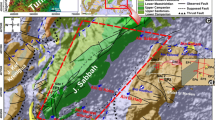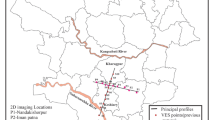Abstract
The cavernous features are considered one of the geological hazards that are dominant in the carbonate rocks as a results of dissolution effect of groundwater. The dissolution process extends for many years at the subsurface layers and causes catastrophic collapse if migrated to the surface layers. The problem become crucial in the urbanization areas where there are wide varieties of construction activities. Beside the natural weathering process, the human interventions, representing in the wastewater, can accelerate the weathering process of the prevailing cracks. Al Kharj governorate is one of the promising areas close to Riyadh, the capital of Saudi Arabia, that attracts wide aspects of urbanization, agriculture and industrial activities. The study area is located inside an urban neighborhood at the western part of Al Kharj city. The site is surrounded by buildings extensions from three sides and the fourth side was excluded from urbanization activities due to existence of surface cracks along the area especially at the northern direction. Excavations and boring tests reveal that the exposed cracks are extended downward and may be connected to subsurface karstic features in the limestone rocks. Two surface geophysical measurements have been planned to provide clear information about the locations, horizontal and vertical extensions of the cavernous features along the study site. The Time Domain Electromagnetic (TEM) and Electrical Resistivity Tomography (ERT) methods were applied for investigating the subsurface characteristics up to 40m depth with different resolutions. The data have been acquired along profiles path across most of the surface fractured features. In spite of the inverted TEM data representing the subsurface resistivity variations in 1D mode, the dense TEM stations and the direct comparing the results with the available borehole lithology, enabled to trace the subsurface cavernous features laterally and vertically with reasonable resolution. Moreover, the 2D ERT processed data have been compared with the TEM results along some localities for guiding the data interpretation to locate the subsurface cavernous features. The two methods are analyzing the subsurface in two different resolutions, the TEM can explore the deeper parts and the layer successions, whereas the ERT methods can provide the lateral extension tracing of cavernous features. Based on the results 3D fence diagrams, most of the cavernous features that are located along the northern part of the study area related to fractured limestone zones extend vertically to more than 20m in some localities. Data interpretation has been flowed by excavation process for confirming the interpreted anomalies and resulted in discovery of huge cavity system extended laterally and vertically at deeper massive limestone layer.















Similar content being viewed by others
Data availability
Data available on request.
References
Abd El Aal A (2016) Identification and characterization of near subsurface cavities in Tuwaiq mountain limestone, Riyadh, KSA. Egypt J Pet 26(1):215–223
Abdelrahman K, Hazaea SA, Almadani SA (2023) Geological geotechnical investigations of the historical Diriyah urban zone in Riyadh, Saudi Arabia: an integrated approach. Front Earth Sci 11:1202534. https://doi.org/10.3389/feart.2023.1202534
Abdullah F, Al-Shuhail A, Sanuade O (2019) Characterization of subsurface cavities using gravity and ground penetrating radar. J Environ Eng Geophys 24(2):265–276
Al-Mutairi KF, Al-Arifi NS (2008) Using GPR and resistivity methods to detect subsurface karst cavities. In: GEO 2008 Middle East Conference and Exhibition, Manama, Bahrain
Anbazhagan P, Panjami K (2023) A study on the effectiveness of various geophysical methods in detecting naturally formed cavities in lateritic deposit. Indian Geotech J. https://doi.org/10.1007/s40098-023-00805-5
Applied Electromagnetic Research (AEMR) (2007) TEM-Researcher Software, Netherlands
Arisona A, Ishola KS, Muliddin M et al (2022) The potential of microgravity technique in subsurface cavities detection at Chan Sow Lin Site in Kuala Lumpur, Malaysia: a case study. Model Earth Syst Environ. https://doi.org/10.1007/s40808-022-01519-y
Bamousa AO, Memesh AM, Dini SM (2014) Morphotectonic development of Mesozoic carbonates and evaporites of Ath-Thumamah depression in central Arabia. Carbonates Evaporites 29:65–72. https://doi.org/10.1007/s13146-013-0173-2
Barsukov P, Fainberg E, Khabensky E (2006) Shallow investigations by TEM-FAST technique: methodology and examples. Methods Geochem Geophys. https://doi.org/10.1016/S0076-6895(06)40003-2
Bharti AK, Singh KKK, Ghosh CN et al (2022) Detection of subsurface cavity due to old mine workings using electrical resistivity tomography: a case study. J Earth Syst Sci 131:39. https://doi.org/10.1007/s12040-021-01781-1
Billi A, Filippis DL, Poncia PP, Sella P, Faccenna C (2015) Hidden sinkholes and karst cavities in the travertine plateau of a highly-populated geothermal seismic territory (Tivoli, Central Italy). Geomorphology 255:63–80
Bosch FP, Müller I (2005) Improved karst exploration by VLFEM-gradient survey: comparison with other geophysical methods. Near Surf Geophys 3:299–310. https://doi.org/10.3997/1873-0604.2005025
Chalikakis K, Plagnes V, Guerin R, Valois R, Bosch FP (2011) Contribution of geophysical methods to karst-system exploration: an overview. Hydrogeol J 19:1169–1180
Cueto M, Olona J, Fernández-Viejo G, Pando L, López-Fernández C (2018) Karst-induced sinkhole detection using an integrated geophysical survey: a case study along the Riyadh Metro Line 3 (Saudi Arabia). Near Surf Geophys 16:270–281. https://doi.org/10.3997/1873-0604.2018003270
Farfour M, Economou N, Abdalla O, Al-Taj M (2022) Integration of geophysical methods for doline hazard assessment: a case study from Northern Oman. Geosciences 12:6. https://doi.org/10.3390/geosciences12060243
Fitterman DV (1987) Examples of transient sounding for ground-water exploration in sedimentary aquifers. Ground Water 25:685–692
Golebiowski T, Porzucek S, Pasierb B (2016) Ambiguities in geophysical interpretation during fracture detection—case study from a limestone quarry (Lower Silesia Region, Poland). Near Surf Geophys 14:371–384
Gómez-Ortiz D, Martín-Crespo T (2012) Assessing the risk of subsidence of a sinkhole collapse using ground penetrating radar and electrical resistivity tomography. Eng Geol 149:1–12. https://doi.org/10.1016/j.enggeo.2012.07.022
Jado A, Johnson D (1983) Solution caverns in the Dammam Dome, Dhahran, Saudi Arabia. Springer, Heidelberg, Germany, pp 69–73
Loke MH (2000) Electrical imaging surveys for environmental and engineering studies. a practical guide to 2-D and 3-D surveys, p 61
Loke MH (2004) Tutorial: 2-D and 3-D electrical imaging surveys. Geotomo Software, Res2dinv 3.5 Software
Manuel Cueto M, Olona J, Fernández-Viejo G, Pando L, López-Fernández C (2018) Karst-induced sinkhole detection using an integrated geophysical survey: a case study along the Riyadh Metro Line 3 (Saudi Arabia). Near Surf Geophys 16:270–281. https://doi.org/10.3997/1873-0604.2018003270
McNeill JD (1990) Use of electromagnetic methods for groundwater studies. In: Ward SH (ed) Geotechnical and environmental geophysics, vol 1: Review and tutorial. Society of Exploration Geophysics Investigations No 5, pp 107–112
Memesh AM, Dini SM, Gutiérrez F, Wallace CA (2008) Evidence of large-scale subsidence caused by interstratal karstification of evaporites in the interior homocline of central Saudi Arabia. European Geosciences Union General Assembly Geophysical Research Abstracts 10: A-02276
Metwaly M, AlFouzan F (2013) Application of 2-D geoelectrical resistivity tomography for subsurface cavity detection in the eastern part of Saudi Arabia. Geosci Front 4(4):469–476
Mogren S (2020) Integrated use of electrical resistivity tomography and ground penetration radar for identifying subsurface sinkholes in Rufa Graben, Central Riyadh. Arab J Geosci 13:19. https://doi.org/10.1007/s12517-019-5017-5
Mohamed AME, El-Hussain I, Deif A, Araffa SAS, Mansour K, Al-Rawas G (2019) Integrated ground penetrating radar, electrical resistivity tomography and multichannel analysis of surface waves for detecting near-surface caverns at Duqm area, Sultanate of Oman. Near Surf Geophys 17:379–401
Ogilvy RD, Cuadra A, Jackson PD, Monte JL (1991) Detection of an air-filled drainage gallery by VLF resistivity method. Geophys Prospect 9:845–859. https://doi.org/10.1111/j.1365-2478.1991.tb00347.x
Orfanos C, Apostolopoulos G (2012) Analysis of different geophysical methods in the detection of an underground opening at a controlled test site. J Balkan Geophys Soc 15:7–18
Putiška R, Nikoláj M, Dostal I, Kŭsnirák D (2012) Determination of cavities using electrical resistivity tomography. Contrib Geophys Geodesy 42(2):201–211
Reynolds JM (1997) An introduction to applied and environmental geophysics. Wiley, Chichester, p 796
Riddle G, Riddle C, Schmitt D (2010) ERT and seismic tomography in identifying subsurface cavities. Geo Can Work Earth 1:1–4
Sanlaville P (2000) Le Moyen-Orient arabe. Le milieu et l’homme. A. Colin, Paris
Shaaban H, El-Qady G, Al-Sayed E, Ghazala H, Taha AI (2019) Shallow groundwater investigation using time-domain electromagnetic (TEM) method at Italy El-Baroud, Nile Delta, Egypt. NRIAG J Astron Geophys 5(2):323–333. https://doi.org/10.1016/j.nrjag.2016.05.004
Sharief FA, Khan MH, Magara K (1991) Outcrop-subcropsequence and diagenesis of Upper Jurassic Arab-Hith Formations, central Saudi Arabia. J King Abdulaziz Univ Earth Sci 4:105–136
Sheehan JR, Doll WE, Watson DB, Mandell WA (2005) Application of seismic refraction tomography to karst cavities. In: Proceedings of the U.S. geological survey Karst interest group proceedings, Rapid City, SD, USA, 12–15 September 2005. U.S. Geological Survey Scientific Investigations Report, 5160
Tao M, Chen Xi, Cheng Q, Binley A (2022) Evaluating the joint use of GPR and ERT on mapping shallow subsurface features of karst critical zone in southwest China. Vadose Zone J 21:e220172. https://doi.org/10.1002/vzj2.20172
Tayyeb MH (2017) Detection of shallow subsurface cavities using 2D & 3D electrical resistivity tomography along the red sea coast, Duba region, Tabuk-Saudi Arabia. Thesis (M.Sc.), King Fahd University of Petroleum and Minerals, Bibliograph, pp 65–71
Vaslet D, Al-Muallem MS, Maddah SS, Brosse JM, Fourniguet J, Breton JP, Le Nindre YM (1991) Geologic map of the Ar Riyadh Quadrangle, Sheet 24 I, Scale 1:250,000, Kingdom of Saudi Arabia. Saudi Arabian Deputy Ministry for Mineral Resources Geoscience Map GM-121, 54 pp
Youssef AM, El-Kaliouby HM, Zabramawi YA (2012a) Integration of remote sensing and electrical resistivity methods in sinkhole investigation in Saudi Arabia. J Appl Geophys 1(87):28–39
Youssef A, El-Kaliouby H, Zabramawi Y (2012b) Integration of remote sensing and electrical resistivity methods in sinkhole investigation in Saudi Arabia. J Appl Geophys 87:28–39. https://doi.org/10.1016/j.jappgeo.2012.09.001
Youssef MA, Al-Harbi MH, Gutierrez F, Zabramwi AY, Bulkhi BA, Zahrani AS (2015) Natural and human-induced sinkhole hazards in Saudi Arabia: distribution, investigation, causes and impacts. Hydrogeol J 24(3):625–644. https://doi.org/10.1007/s10040-015-1336-0
Youssef AM, Al-Harbi HM, Gutiérrez F, Zabramwi YA, Bulkhi AB, Zahrani SA, Bahamil AM, Zahrani AJ, Otaibi ZA, El-Haddad BA (2016) Natural and human-induced sinkhole hazards in Saudi Arabia: distribution, investigation, causes and impacts. Hydrogeol J 24(3):625–644. https://doi.org/10.1007/s10040-015-1336-0
Zijian Y, Ying Y (2019) Comparison of detection effect of cavities behind shield tunnel segment using transient electromagnetic radar and ground penetrating radar. Geotechn Geol Eng 37:4391–4403. https://doi.org/10.1007/s10706-019-00916-y
Acknowledgements
The authors would like to thank the Research Supporting Project number (RSP2024R89), King Saud University, Riyadh, Saudi Arabia for funding this work.
Author information
Authors and Affiliations
Contributions
M. Metwaly and E. Elawadi., conceived, planned and carried out the data acquisition and analysis. S. Moustafa, A. Abu Halawa and F. Shaaban, contributed to the interpretation of the results. All authors took the lead in writing the manuscript and contributed in the preparation of the figures and finalizing the manuscript.
Corresponding author
Ethics declarations
Conflict of interest
The authors declare that they have no known competing financial interests or personal relationships that could have appeared to influence the work reported in this paper.
Additional information
Publisher's Note
Springer Nature remains neutral with regard to jurisdictional claims in published maps and institutional affiliations.
Rights and permissions
Springer Nature or its licensor (e.g. a society or other partner) holds exclusive rights to this article under a publishing agreement with the author(s) or other rightsholder(s); author self-archiving of the accepted manuscript version of this article is solely governed by the terms of such publishing agreement and applicable law.
About this article
Cite this article
Metwaly, M., Elawadi, E., Moustafa, S.S.R. et al. Detecting cavernous features in Al Kharj, Saudi Arabia: advancements in TEM and ERT geophysical measurements. Environ Earth Sci 83, 235 (2024). https://doi.org/10.1007/s12665-024-11523-3
Received:
Accepted:
Published:
DOI: https://doi.org/10.1007/s12665-024-11523-3




